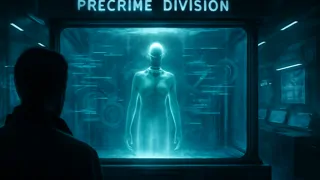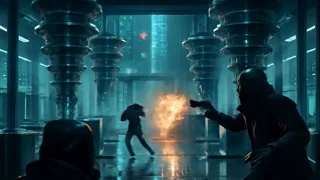Introduction
In the sprawling heart of New Washington, the edge of dawn cuts through the neon haze as silent towers awaken. Beneath this pulsating skyline, the PreCrime Division stands as humanity’s greatest promise and gravest moral dilemma. Inside the fortified precinct, three gifted visionaries, the PreCogs, drift in suspended glass vats, knowing the crimes that have not yet happened. Their gifts of foresight fuel algorithms that arrest malice before it can find a mortal host. Detective Samuel Hayes, a grizzled veteran with decades on the force, steps into the glossy foyer as the latest crisis unfolds. A new nightmare emerges: a vision of his own colleague falling to a mysterious fate. When a single, discordant minority prediction surfaces—one that contradicts the consensus—Hayes must navigate the labyrinthine corridors of justice and distrust. Each corridor hums with electric tension, every wall lined with screens flashing possible futures. In an age of guaranteed security, can one man’s unwavering belief in free will challenge an infallible system? Can truth survive in a world where tomorrow’s crimes are yesterday’s headlines? The answer lies somewhere between data and destiny, where the slim thread of hope flickers like a dying star. Welcome to a future where every thought counts, and every secret has a price.
Dawn of Precrime
As the first shafts of sunlight pierced the horizon, the PreCrime Division hummed with quiet energy. Sensors embedded in every street corner transmitted streams of data to the central hub, where towers of servers churned them into a tapestry of potential futures. Floor-to-ceiling monitors tracked each citizen’s movements, connecting dots between digital footprints and latent intent. At the center of this operation were the PreCogs—three individuals born with a gift and also a curse: sight of actions yet to occur. Encased in transparent tanks and kept in perpetual twilight, they remained both prophets and prisoners. The consensus of their visions shaped the unerring hand of justice. Under the watchful gaze of Director Una Morales, lieutenant officers prepared arrest protocols alongside broadcast drones that glided above the city’s skyline. Yet for all its precision, an undercurrent of unease ran through the marble halls: How certain could one fate truly be?

For Detective Samuel Hayes, the system had always been both salvation and burden. He’d seen the city plunge into chaos before predictive arrests skyrocketed. Gang wars, serial arson, and the unending drip of blood-soaked headlines had scarred his conscience. But when PreCrime rendered future violence obsolete, Hayes embraced the promise wholeheartedly. Every coup foiled and every massacre preempted felt like a victory for humanity. Yet each time the PreCogs stirred in their incubation pods, a hollow pity gripped him. They sacrificed their freedom to safeguard strangers who might never grasp the cost of their protection. On the day Owen Pierce—a decorated officer and dear friend—was flagged by a dissenting prevision, Hayes’s resolve buckled. A lone prediction surfaced amidst the trio’s usual harmony: Pierce would become both judge and executioner of an innocent man.
As alarms shivered through the compound, Hayes raced down the corridors, the soft thrum of hovering drones trailing after him. Data streamers danced across glass walls, each ticker offering a glimpse into diverging timelines. The majority PreCogs forewarned of one crime, but the minority vision—a fragment deemed an anomaly—hinted at a darker twist: a planted memory, manipulated evidence, and a frame-up by unseen hands. If Pierce carried out the order, the system would brand it a righteous act. No jury, no appeal, just the cold calculus of preordained justice. Hayes’s mind spun with questions: Could fate be rewritten? Was free will an illusion or a last beacon of hope? Confronted with the potential execution of his friend, he faced a choice as stark as any precrime scenario—submit to omnipotent algorithms or risk everything to uncover the hidden truth.
The Minority Whisper
Navigating the labyrinth of secure corridors, Hayes traced a faint anomaly in the system log—an encrypted signal that pulsed just before Pierce’s arrest warrant materialized. He tapped into an abandoned subroutine, finding footprints of code overwritten by phantom operators who had burrowed into PreCrime’s heart. Late nights behind the console blurred into whirs of data and the steady beeps of his tachometer rising. Guided by dim biometric scanners, Hayes decrypted audio fragments that aligned with the minority report: a whispered accusation from a PreCog named Vega, whose consciousness had been jacked into a hidden network of black market vision brokers. Their crime: trafficking forbidden glimpses of tomorrow for personal gain.

Hayes’s pulse thundered as he realized the implications: someone manipulated the PreCogs, injecting false memories to manufacture crimes and control outcomes. The betrayal felt like a blade twisting in his gut. To confirm his fears, he needed access to the Isolation Wing—where Vega’s pod sat in quarantine, her visions encapsulated in sealed data vaults. Disguised as a system technician, Hayes slipped past retinal scanners and moved through corridors bathed in strobe reflections. Each step brought him closer to the pulsing glass sarcophagus, where Vega’s silhouette drifted like a drowned soul. He inserted a bypass keycard.
As Vega’s eyes fluttered beneath the viscous fluid, his instruments picked up her tremors. She murmured three words: "The choice remains", before a data burst freed a torrent of disjointed images into his terminal—echoes of conspiracies, forged evidence, and the machinery of a silent coup. Morales’s voice crackled through the comm channel, crisp and authoritative: "Detective Hayes, step away from unauthorized equipment." The moment crystallized around him. Hayes had become a fugitive in the very institution he served. With the minority report hovering on his screen like a beacon of truth, he realized his mission: to expose corruption, save his friend, and challenge the unyielding logic of prophecy.
Rebellion of Foreknowledge
Outside the crystalline halls of speculation, Hayes and Vega convened in an unmarked safe house nestled among the city’s crumbling underbelly. The stale scent of oil and printer toner clung to the air, punctuated by the distant echo of maintenance bots. Hunched over a battered terminal, they devised an audacious plan: infiltrate the core intelligence located deep beneath the city’s strip—where quantum arrays processed trillions of possible future timelines per second. Vega, her mind tethered to every signal the PreCrime network produced, offered guidance on the labyrinth’s secret backdoors. With each keystroke, the boundary between chosen destiny and free will blurred. They would upload a reversal algorithm, one that inverted the previsions, forcing the system to reveal its hidden architects.

Sirens howled through the pipes as they breached the vault’s heavy airlock. Robotic sentries pivoted on silent joints, their red optics scanning for anomalies. Pierce’s name flashed across the transmission log, tethered to a countdown: the moment he would execute an innocent man. Hayes inhaled sharply, memories of shared laughter and late-night strategy sessions swirling. This was no Turing test. He was testing the very essence of humanity. Hydraulic doors groaned open, revealing the quantum core’s labyrinth of mirrored panels and glowing pentagonal cells. Vega’s voice resonated through his earpiece, calm but urgent: "Target the primary nexus. Introduce the minority sequence."
As Hayes approached the central console, searchlights carved arcs across the chamber. Mechanical claws snaked from overhead conduits, aiming to immobilize intruders. With a final catastrophic keystroke, he launched Vega’s code, and every monitor erupted in static. Futures fragmented; blueprints of terror and triumph collided in kaleidoscopic flux. Vega cried out, her voice a prism of thousand overlapped images. The algorithm pushed its way to the surface, rewiring judgment before the next sunrise. In that furious moment, Pierce raced down the corridor, conscience torn between duty and doubt. Seeing the override in action, he lowered his weapon—betrayed by the faith he couldn’t unsee.
In the aftermath, as dawn’s first gold filtered through the shattered dome, Hayes carried Vega from her tank. Her skin shimmered with residual data, and she whispered, "Truth is not a single path." Minutes later, they surfaced into the open streets, where the city’s awakening pulse felt different—uncertain, yes, but alive with possibility. News bulletins splashed across holo-billboards: PreCrime’s infallibility had fractured; new oversight committees were forming; survivors debated the rights of prophets and free will. Through the haze of neon and the chatter of drones, Hayes allowed himself a single, unguarded smile before vanishing into the crowds alongside his transformed world.
Conclusion
In the days that followed, New Washington stood at a crossroads. The collapse of PreCrime’s unblemished record fractured public trust, ignited fierce debates, and forced a reckoning with lessons unanticipated. Veterans like Detective Hayes navigated a city in flux, where the echoes of foiled tragedies mingled with the bitter residue of lives nearly destroyed. But amid the upheaval, a new hope emerged—an alliance between broken prophets and human jurors who would share the weight of judgment. Legislators drafted safeguards to protect PreCogs from exploitation, funding restorative therapies and individual rights commissions. Holo-panels replaced secret algorithms, inviting communal oversight rather than unseen guardians. For Vega, freedom meant more than emancipation from her tank; it meant choosing her own truth. And for Hayes, it meant honoring the flickering flame of uncertainty that made every choice sacred. In a society once defined by predetermination, humanity reclaimed its most vital gift: the power to shape tomorrow from the fragments of what might have been.

















